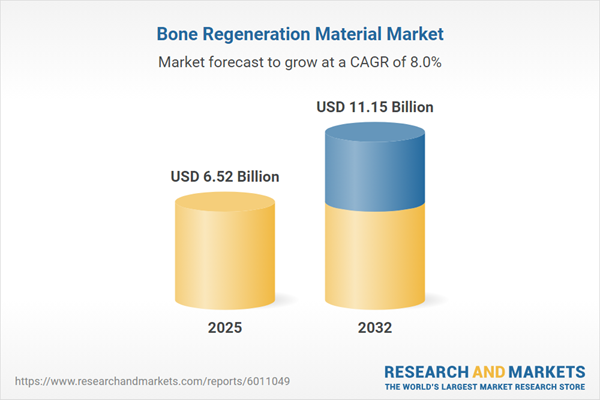Speak directly to the analyst to clarify any post sales queries you may have.
The bone regeneration material market continues to evolve as clinical innovation, regulatory developments, and operational priorities reshape strategic focus for healthcare organizations. Senior decision-makers must anticipate market complexity and balance evolving clinical needs with resilient procurement and supply strategies to drive sustainable value.
Market Snapshot: Bone Regeneration Material Market
In 2024, the global bone regeneration material market reached a valuation of USD 6.03 billion, with a compound annual growth rate (CAGR) of 7.97%. This growth is underpinned by expanding adoption of minimally invasive surgical approaches and advancements in biomaterial technology, which enable healthcare providers to enhance patient outcomes and support faster recoveries. As regulation becomes more stringent and the competitive landscape intensifies, manufacturers and healthcare institutions are increasingly reassessing procurement strategies and operational models. Differences in regulation and reimbursement across regions highlight the need for robust supply chain management and emphasize the strategic importance of remaining agile in response to shifting market trends.
Scope & Segmentation of the Bone Regeneration Material Market
- Material Types: Ceramics, biphasic calcium phosphate, calcium sulfate, hydroxyapatite, tricalcium phosphate, composites, metals, collagen, natural growth factors, polycaprolactone, polyglycolic acid, and polylactic acid—each offering unique durability, biocompatibility, and clinical performance profiles needed to address broad and complex requirements.
- Applications: Dental implantology, periodontal repair, ridge augmentation, bone defect filling, fracture stabilization, joint reconstruction, spinal therapies, and trauma care—spanning general orthopedics and specialty disciplines.
- End Users: Ambulatory surgical centers, dental clinics, community hospitals, specialty care facilities, university-affiliated institutions, and research organizations—supporting process modernization, precision treatment, and post-procedural recovery across multiple care environments.
- Delivery Forms: Blocks, gels, macro- and microporous granules, membranes, injectable formats, and moldable putties—enabling both complex interventions and routine tissue repair to be conducted with enhanced versatility and control.
- Regional Coverage: Americas, Europe, Middle East & Africa, and Asia-Pacific—each shaped by varying regulatory requirements, reimbursement systems, and adoption trends that influence procurement and technological development.
- Key Companies Profiled: Medtronic plc, Stryker Corporation, DePuy Synthes, Inc., Zimmer Biomet Holdings, Inc., Baxter International, Inc., Orthofix Medical Inc., Geistlich Pharma AG, and BioHorizons IPH, Inc.—all recognized for pursuing advancement and operational reliability on a global scale.
Key Takeaways for Decision Makers
- Continued innovation in composite and bioactive materials expands options for clinical practice, accommodating new models of care and patient-specific interventions.
- Precision engineering and adoption of additive manufacturing techniques support the development of advanced biomaterials tailored to challenging anatomical and individualized cases.
- Collaboration among manufacturers, biotech firms, and research institutions accelerates the introduction of new products while supporting compliance with rapidly evolving regulations.
- Regional diversity in procurement and reimbursement creates a demand for flexible supply partnerships and timely access to local market intelligence.
- Prioritizing environmental, social, and governance (ESG) standards is driving the integration of sustainable sourcing practices and the establishment of transparent, traceable supply networks.
Tariff Impact: Policy Shifts and Supply Chain Strategy
Ongoing adjustments in global trade policy and the introduction of tariffs are influencing sourcing and manufacturing choices, especially within ceramics and polymer categories. Organizations are responding to higher import costs and potential supply interruptions by strengthening local production capabilities, integrating supply chain processes, and revisiting partner frameworks. The use of bonded warehousing and duty drawback programs helps to mitigate tariff risks and maintain favorable cost structures. Continuous review of procurement strategy and prompt response to evolving policy are essential for operational and financial targets.
Methodology & Data Sources
Findings are based on structured contributions from clinicians, regulatory experts, procurement leaders, and manufacturing executives. All insights are reviewed and validated using peer-reviewed research, corporate documentation, official regulatory filings, and clinical studies to provide decision-grade reliability for senior leadership.
Why This Report Matters for Senior Leaders
- Comprehensive segmentation and analysis inform investment and planning within organizational, procurement, and clinical frameworks.
- Guidance on regulatory and operational challenges strengthens preparedness and cost control for sustainable international operations.
- Emphasis on sustainable practice and cross-sector partnership promotes regulatory compliance and fosters long-term market credibility.
Conclusion
Maintaining strategic alignment with evolving clinical, regulatory, and operational demands is vital for ongoing advancement in the bone regeneration material sector. Informed, agile leadership will support resilience and long-term organizational growth.
Additional Product Information:
- Purchase of this report includes 1 year online access with quarterly updates.
- This report can be updated on request. Please contact our Customer Experience team using the Ask a Question widget on our website.
Table of Contents
3. Executive Summary
4. Market Overview
7. Cumulative Impact of Artificial Intelligence 2025
Companies Mentioned
The companies profiled in this Bone Regeneration Material market report include:- Medtronic plc
- Stryker Corporation
- DePuy Synthes, Inc.
- Zimmer Biomet Holdings, Inc.
- Baxter International, Inc.
- Orthofix Medical Inc.
- Geistlich Pharma AG
- BioHorizons IPH, Inc.
Table Information
| Report Attribute | Details |
|---|---|
| No. of Pages | 187 |
| Published | October 2025 |
| Forecast Period | 2025 - 2032 |
| Estimated Market Value ( USD | $ 6.52 Billion |
| Forecasted Market Value ( USD | $ 11.15 Billion |
| Compound Annual Growth Rate | 7.9% |
| Regions Covered | Global |
| No. of Companies Mentioned | 9 |









